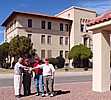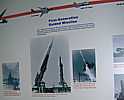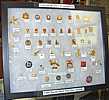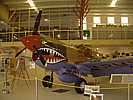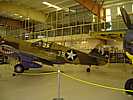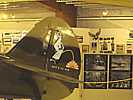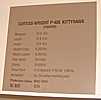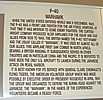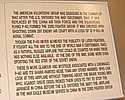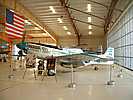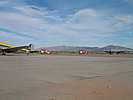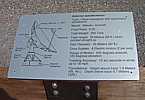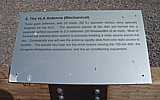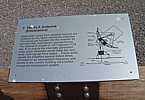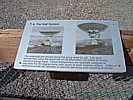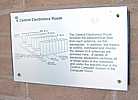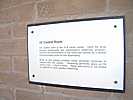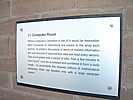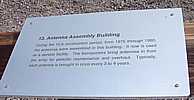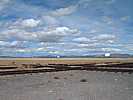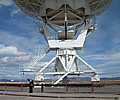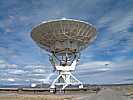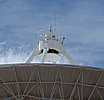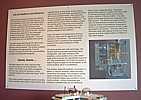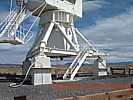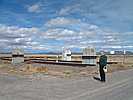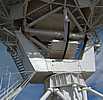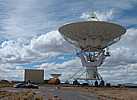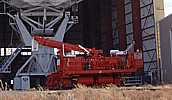2004 Red Canyon Reunion
organized by Ron PickinpaughRon Pickinpaugh rpickinpaugh@comcast.net organized a wonderful four day 2004 Red Canyon Reunion starting Sunday October 17, 2004
- The Set Up
- Formal Activities
- Sunday - Initial Get Together
- CLICK HERE for about 100 of Ron Pickenpuagh's pictures of the 2004 Nike Reunion and its various tours - My Side Trips
- Tuesday - Ft. Bliss & War Eagles Air Museum
- Wednesday PM - Alamogordo
- Thursday - Very Large Array
- Friday - National Atomic Museum - Interesting, but I'm exhausted. - Text of handout at Trinity test site
- Update on Trinitite (Feb 2017)
- Update on Trinitite from Jim Eckles' new book (paperback version)
- Wikipedia
|
A word about organizing a function for say 60 people
living in about 20 different states - it is not for
the faint of heart. Even though Jim Eckles of the
WSMR (White Sands Missile Range) Public Relations
office provided much of the touring and entertainment,
the rest is a bit like a wedding - name tags, posters,
handouts, getting the word out, getting the money in,
getting the meeting room for days, the banquet, the
pictures, the reminders, the - oh - my head hurts.
And Ron did it with a smile, style, and flair :-))
8/17/2004
Here is some reminders about things for the reunion.
1. Bring pictures and memorabilia
2. WSMR security issues
If you plan on taking your car to WSMR for the base
tour day (Wed.), you will need three things for
security checks: Current drivers license,
current insurance card,
current registration
I would advise car pooling as much as possible,
to the base, on the base tour day, as it takes
5-10 minutes to check in and another 5-15 minutes
to get your car through the inspection.
Everyone should bring picture ID's.
For our long tour day on Monday we will be
picked up at the hotel by the WSMR buses.
3. Hilton address: 705 S. Telshor Blvd.
Las Cruces, NM 88011,
505-522-4300
Directions: Take exit 3 East off of I-25
to Telshor Blvd (1 blk),
then South (1 blk),
then east to hotel entrance.
-------------------------------------------------------
9/4/2004
Sunday(Oct. 17th) - Everyone get together in the
meeting room on the 1st floor. Jim Eckles, WSMR,
will give us some of the details about our tours.
Monday(Oct. 18th) - Range tour day at WSMR, starts
at 7:30 A.M. at the Hilton Hotel. The box lunches
will be picked up prior to loading on the buses.
We hope to finish by 5:00 P.M.,
so this will be a long day on the buses.
Tuesday(Oct. 19th) - Free day, go see the sights
Wednesday(Oct. 20th) - Everyone going on the WSMR
base tour needs to meet at the WSMR Museum
at 9:00 A.M. If you are driving to the base
make sure you have all the necessary insurance,
registration and drivers license. We will be
escorted on the base tour in buses and then have
lunch around 11:30 A.M., for those that want to
stay for lunch on the base, at the Frontier Club.
You will be free to leave after lunch.
I suggest you car pool as much as possible.
Banquet: (6 - 10 P.M.) at the Hilton Hotel
Thursday(Oct. 21st) - Departure day
Ron Pickinpaugh
And ordering forms Attachment1 and
Attachment2.
|

Welcome |
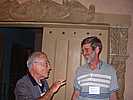
Ron & Jim | Ron Pickenpuagh -
- Organized the reunion. Jim Eckles - - Was WSMR host & tour guide |
War Eagles Air Museum - Side trip to Ft. Bliss with old classmates Tuesday October 19, 2004
-
New Mexico Museum of Space History Alamogordo, NM
- Side trip Wednesday PM, October 20, 2004
-
| . | but I was really struck by the several inertial guidance systems. (I had the last laugh - I found out later that the gyros failed incoming test at Cape Canaveral, presumably because they were out of calibration due to bad temperatures.) The gyros (and related accelerometers) here were made by A.C. Delco Division, General Motors. |
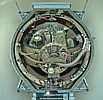
| Atlas Guidance Platform
The Atlas Intercontinental Ballistic missile (ICBM) used a platform like this for guidance. Accelerometers and gyroscopes in the platform sensed acceleration and movement to determine the rocket's altitude and velocity. This data was relayed to the on-board computer. The computer controlled the stabilization and control systems to correct any variations from the required flight path. The same guidance system was used during the manned Mercury orbital missions which utilized the Atlas missile. Gift of the Guidance Test Division, 6585th Test Group, Holloman Air Force Base. |
| , |
A tribute to Charles Draper in the museum Charles Stark Draoer Dr. Charles S. Draper (1901-1987), born in Widsor, Missouri, was educated at Stanford University and the Massachusetts Institute of Technology (MIT). Draper earned his doctorate from MIT in Physics in 1938. As a member of the faculty at MIT, Draper founded the Instrument Laboratory in 1939. In 1973, the laboratory became independent and was named the Charles Stark Draoer laboratory. Dr. Draper evolved the theory, invented and developed the technology, and led the effort which brought inertial mavigation to missiles and space vehicles. Under Draper's direction, the MIT Draper Laboratory developed guidance systems for the Atlas and Titan rockets. In 1961, Dr. Draper's laboratory developed the Apollo Guidance and Navigation System. |
Very Large Array - Thursday Oct 21, 2004
|
Very Large Array - 50 miles west of Socorro
- Visitor Center opens 8:30
In the ideal world, a well made 6" amateur telescope can approach the resolution of 1 arc second, 1/3600 of a degree. Not bad you say, you can see the fuzz on a bear at say 50 meters - but there are applications in astronomy where better resolution is very useful. Theoretical resolution (angular ability to resolve to adjacent stars or lines) is a function of (wave length)/(diameter of the collector). If you want a small angle of resolution, a shorter wave length is "good", a larger collector (lens) is "good". Oddly, optical astronomical telescopes dealing with the vagaries of the earth's atmosphere struggle to obtain resolutions (pixel size if you will) better than the one second of arc resolution obtainable with a 6 inch amateur telescope. The bigger ones indeed collect more light, but resolving smaller angles is a problem due to the earth's atmosphere :-(( The struggle for better resolution caused us to go above the earth's atmosphere with the various space telescopes (Hubble currently the largest). This has worked well to get the angular resolution down to about 0.1 arc second, but is hideously expensive and inconvenient. Intensive recent work with adaptive and active optics is permitting ground telescopes to approach the resolution of the Hubble telescope. We have all been WOWed by the high resolution obtainable by the radio telescope people. One would think that radio telescope people using waves of say 0.05 meters (6 gigahertz) would be at a disadvantage compared with the optical folks dealing with wavelengths of say 0.5x10^-6 meters - 10,000 longer - Currently the largest radio telescope, operating daily as a single unit, is the Very Large Array (VLA) located on some ranch land 50 miles west of Socorro, New Mexico. The 27 dishes can be arranged to act as one antenna having an effective diameter of 36,000 meters. For about the same price you can make a 10 meter optical telescope (Keck on Mauna Kea)
From http://www.vla.nrao.edu/genpub/overview/
However, to solve special problems, it is practical to make radio telescopes with an effective aperture of continents using atomic clocks to retain phase during recording (again using interferometry and fancy computing). VLA is frequently used as part of these efforts.
About three miles south of U.S. Highway 50, near the center of the Very Large Array, there is the administrative and technical center. There is also a visitors center and gift shop - lots of info, not very fancy. (No attempt to inform you on the complex operation of converting the radio wave fronts into maps of the radio sources. That seems to be a serious task with corrections required for everything.) From the visitor's center you can go to the 1/4 mile self guided walking tour. Here are some of the very helpful placards placed in strategic places on the trail.
And some scenes from the self-guided walking tour
| ||||||||
